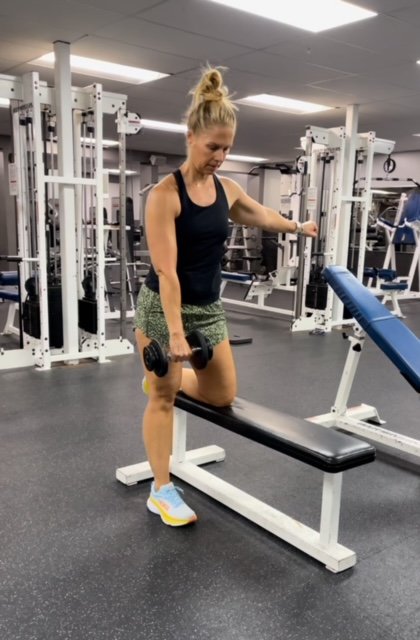Conquering Plantar Fasciitis Through Smart Choices and Consistent Care
Health + Wellness
Plantar fasciitis can feel like a never-ending battle. That sharp, stabbing pain in the heel can turn simple activities like walking or standing into a painful ordeal. For athletes, wellness enthusiasts, and anyone who enjoys being active, plantar fasciitis can be a significant roadblock. However, with the right approach, it's possible to find relief and regain control over your life. In this blog post, I'll share my personal journey with plantar fasciitis and explain how specific shoes, inserts, and physical therapy techniques have helped me manage and overcome this condition.
The following content may contain affiliate links. When you click and shop the links, we receive a commission.
Understanding Plantar Fasciitis
Plantar fasciitis is a common cause of heel pain. It involves inflammation of a thick band of tissue called the plantar fascia, which runs across the bottom of your foot and connects your heel bone to your toes. This condition typically causes a stabbing pain that occurs with your first steps in the morning. The pain usually decreases as you move around, but might return after long periods of standing or after getting up from sitting.
Common causes of plantar fasciitis include excessive walking or running, improper footwear, obesity, and high arches or flat feet. The pain can be debilitating, making it difficult to continue with daily routines or exercise regimens.
My Personal Experience with Plantar Fasciitis
My experience with plantar fasciitis began a few years ago. I was an avid runner, logging several miles each week. One morning, I woke up with a sharp pain in my heel. At first, I thought it was just a temporary issue, but as days turned into weeks, the pain only got worse. Running became unbearable, and even walking around the house was excruciating.
I tried various over-the-counter pain relievers and ice packs, but nothing seemed to help. Frustration set in as I struggled to find a solution. It wasn't until I started researching and consulting with professionals that I began to find methods that actually worked. When working with a podiatrist based on my gate, this is what he recommended for shoes. Then, I ordered every single pair listed on this list below and found my two favorites. I also ordered 3 tools and froze a half filled water bottle in my freezer and rolled my swollen heels on them, which also helped break up the tension on the bottom of my foot.
Doctors recommended footwear guide
The Role of Proper Footwear and Inserts
One of the biggest revelations during my battle with plantar fasciitis was the importance of proper footwear and inserts. The right shoes can make a world of difference in managing and preventing this condition. My podiatrist recommended several brands and types of shoes that provided the necessary support and cushioning.
Recommended Shoes
Here are some of the shoes that were recommended to me:
Asics Gel Nimbus and Gel Cumulus: These shoes offer excellent cushioning and support, making them ideal for those with plantar fasciitis. I found the Gel Nimbus to be particularly comfortable due to its plush feel. Third pick for me, I really liked the comfort and the wide footbed, but for me the Bondi by Hoka made the biggest difference.
HOKA Bondi and Gaviota (my personal favorite): HOKA shoes are known for their thick, cushioned soles. The Bondi model, in particular, provided me with the maximum comfort and support needed to alleviate my heel pain. I personally love the Bondi the best, when I tried on the Gaviota I had a weird forefoot pain and rub. The Bondi won the all around for Hoka.
Brooks Ghost and Dyad: Brooks shoes are designed with a focus on comfort and support. The Ghost model offered a smooth ride, while the Dyad provided additional stability. This was my second choice Brooks Ghost and this shoe is a great running shoe all around.
Oofos: These recovery shoes are specifically designed for those with foot pain. Their patented Oofoam technology provides incredible cushioning and support, making them a great option for plantar fasciitis sufferers. I personally didn’t love OOFOS, the strap between my toes really hurt for the flip-flops and the regular sandal was just too much of a shoe and actually made my arch worse, so I wear Birkenstocks all day long, every day, I wrote a blog post on how to style the rubber black Birkenstocks that you can read here.
Birkenstocks: The classic Birkenstock sandals or the rubber style are a staple for those with plantar fasciitis. Their contoured footbed and adjustable straps provide optimal support and alignment for the feet. Plus, they come in a variety of stylish designs to suit any outfit.
Orthofeet Charlotte Slippers: For those looking for comfortable indoor footwear, the Orthofeet Charlotte slippers are a great choice. They feature an orthotic insole with arch support and cushioned heel, perfect for relieving pain from plantar fasciitis. They also have a non-binding upper and wide toe box for additional comfort.
shop Hoka Bondi
Comfort and Neutral Shoes
After testing various brands, I found the HOKA Bondi to be the most comfortable for my needs. It's worth noting that the type of shoe—whether neutral or with added support—should be chosen based on individual foot structure and gait. Neutral shoes can be suitable for those with normal arch support, while those with flat feet or high arches might benefit from shoes with additional stability features. I've also at times used, within my shoes, this insert which has helped tremendously with my pain. I've battled this for years, so I hope this is helpful in reducing your pain.
Physical Therapy Techniques and Exercises
In addition to wearing the right shoes, physical therapy played a crucial role in my recovery. My physical therapist recommended a series of exercises and techniques to strengthen the muscles in my feet and lower legs, improve flexibility, and reduce pain.
Stretching Exercises
Stretching the calf muscles and the plantar fascia itself can help relieve tension and reduce pain. My therapist suggested the following stretches:
Calf Stretch: Stand facing a wall with your hands on the wall at shoulder height. Step one foot back and keep it straight with the heel on the ground. Bend the front knee and lean forward until you feel a stretch in the calf of the back leg. Hold for 30 seconds and switch legs. I really like this wedge, here to stretch. I also have this one, which has a bit more tension, but make sure not to go far to overstretch the Achilles.
Plantar Fascia Stretch: Sit down and cross one leg over the other. Hold the base of your toes and pull them back towards your shin until you feel a stretch in the arch of your foot. Hold for 15-30 seconds and repeat three times.
Strengthening Exercises
Strengthening the muscles in your feet and lower legs can help support the plantar fascia. Here are a few exercises I found beneficial:
Towel Scrunches: Place a towel on the floor and use your toes to scrunch it towards you. Repeat for two minutes.
Heel Raises: Stand on the edge of a step with your heels hanging off. Slowly rise onto your toes and then lower your heels below the step level. Perform three sets of 10-15 repetitions.
Ice and Massage
Applying ice to the affected area and massaging the plantar fascia can help reduce inflammation and alleviate pain. I used a frozen water bottle to roll under my foot for 10-15 minutes, which provided significant relief.
Tools that have helped me with plantar fasciitis
Lifestyle Adjustments for Plantar Fasciitis Relief
While proper footwear and physical therapy are essential, making certain lifestyle adjustments can also help manage plantar fasciitis effectively. Here are some tips that worked for me:
Modify Daily Activities
To reduce strain on your feet, avoid prolonged standing or walking on hard surfaces. If your job requires you to stand for long periods, consider using cushioned mats or taking regular breaks to sit down and rest your feet.
Maintain a Healthy Weight
Carrying excess weight can put additional stress on your feet, exacerbating plantar fasciitis symptoms. Maintaining a healthy weight through a balanced diet and regular exercise can help alleviate this pressure.
Warm-Up and Cool Down
Before engaging in physical activities, always warm up your muscles and perform gentle stretches. Similarly, cool down with stretches after exercising to prevent stiffness and injury, and make sure to stretch your calves, I use this slat board and the Vive Foot Rocker, make sure not to overstretch on this! The Tiger Tail is fantastic to help break up the anterior tibialis to help lessen pain and when I’m watching TV or Netflix, I use the Yoga Toes which has helped my neuroma and plantar fasciitis.
Plantar fasciitis can be a challenging condition to manage, but with the right approach, relief is possible. My journey with plantar fasciitis taught me the importance of proper footwear, physical therapy, and lifestyle adjustments in managing this condition. Early intervention and a balanced approach can make a significant difference in your recovery process.
If you're struggling with plantar fasciitis, don't lose hope. Explore different solutions, consult with professionals, and find what works best for you. Remember, every step towards finding relief is a step in the right direction.
For those looking to take their recovery to the next level, I encourage you to share your experiences and seek professional advice. If you're interested in learning more about managing plantar fasciitis or want to explore related products and services, check out the link below.
Stay active and take care of your feet!
I love helping my clients let go of painful experiences to help them rebuild trust, self-confidence, self-worth and belief in themselves by addressing the root causes with subconscious change. The tool I use is called PSYCH-K®, and is a quick, pain-free and completely safe way to reprogram your subconscious and to create lasting change for once and for all.
Within my holistic practice, we help you create a lasting self-care practice to regulate your nervous system in your day to day-to-day life, so you can always hear and follow your whispers, instead of the big Mac truck.
If you’re ready to stop dimming your light, start making easy decisions with confidence, and follow through with what you want to achieve, while trusting your intuition, you can easily set up a free conversation with me.
>>>To Book Integrative Energetic Healing Services, click here
You might also like:
My 7 Day Clean Eating Guide Eating 100g of Protein (No bars or protein powder)
How to Heal and Help Your Anxiety with Six Tools to Use Daily
Spring Cleaning Made Easy: How to Get Your House Fresh and Clean in Just One Day
Here’s a great total body workout that you can do from home. As a personal trainer for over 20 years, the most important piece when it comes to your health is making sure you are CONSISTENT. If you aren’t consistent, then you will never see results.
I love seeing you all tag me on Instagram! It’s so fun when you complete a workout and show me your progress. Allow me to cheer you on! Tag me if you try this workout @__angiebloom__
One More Post I Think You’ll Love >>>
A Favorite Post: Try my Favorite Healthy Cookie Dough























